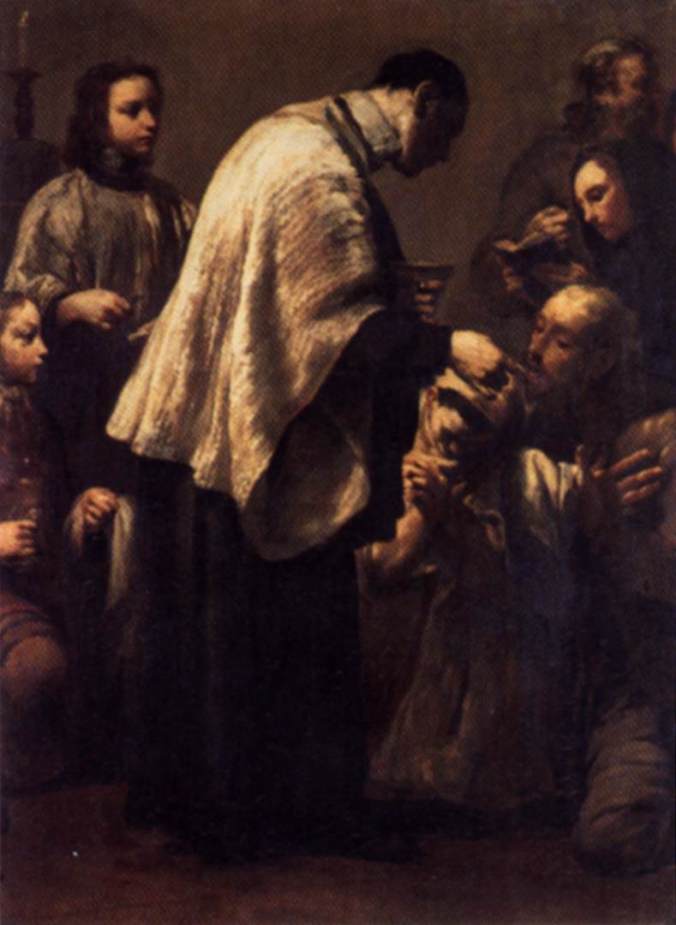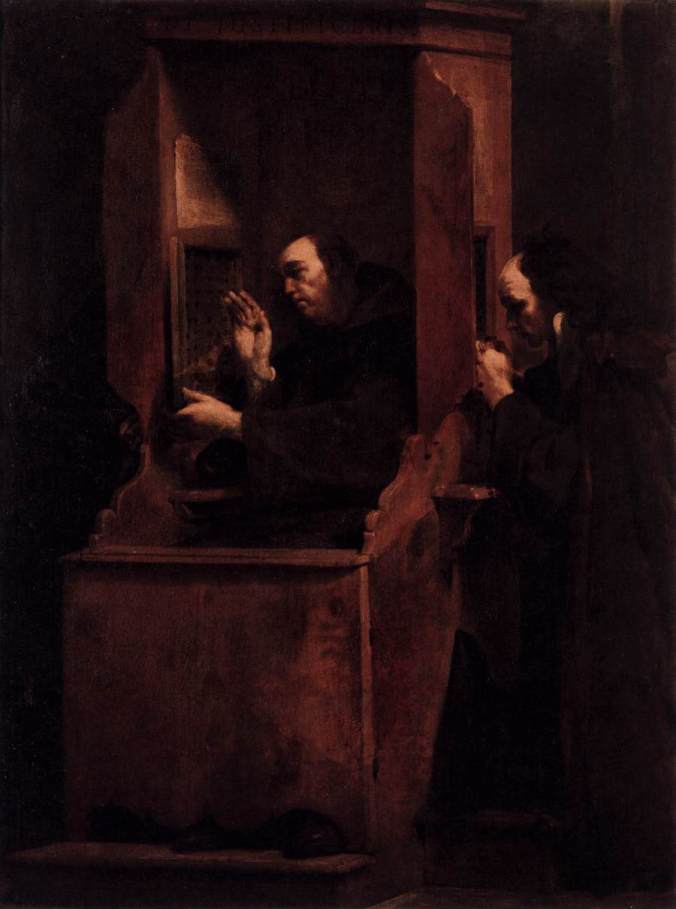
A depiction of Pentecost (and thus Our Lady of the Cenacle) in an illuminated A from a Lombard antiphonal, 1430’s. Attributed to Stefano da Verona and now in the possession of the Getty Museum. Not a Bible, though. (Source)
Erasmus, that mercurial fellow of the Renaissance who did so much damage with such good intentions, hoped that the humanist scholarship then revolutionizing Biblical studies would produce a popular spiritual awakening. He foresaw a time when, the Bible having been translated into vernacular languages, “the farmer would sing parts of the scripture at the plow, the weaver hum them to the movement of his shuttle, the traveller lighten the weariness of his journey with like stories.” What he got was the Reformation.
Those of us Catholics who have the benefit of historical hindsight can perhaps treat Erasmus with a degree of charity. He did not foresee the storm that he was helping to prepare. At best, his image of the Word-infused society is one that we can and ought to strive for. But things have gone rather differently in what used to be Christendom. The plurality of conflicting Biblical interpretations, stemming both from theological divisions and from theologically-motivated translations from the standard scriptural texts of pre-modernity, has eroded the communion of the full body of Christians. Though by no means the only factor in secularization, this loss of even the pretense of unity significantly impaired the Church’s evangelical witness.
But of course, certain divisions along theological lines always existed in pre-modernity as well. Heretics, mystics, and scholars often disagreed with the orthodox establishment over various exegetical points, and sometimes those divisions were backed by political force. So, what made the Reformation different? Perhaps it was the material condition that stands behind Erasmus’s vision – the advent of the printing press. After all, the mass dissemination of information that the printing press spread and entrenched the Reformation (and the Catholic Reformation) as early as Luther’s first moves in 1517.
But I wish to speak less of early modernity and more of our own era. And, standing firmly in our present moment, I must conclude that printing the Bible was a mistake. Or, to be precise, the mass production of Bibles was a mistake.
An Observation
Walk into any sizeable book store – a Barnes and Noble or Books-A-Million, perhaps. Wander the shelves and you will no doubt eventually come upon the Bible section, sometimes rows and rows of it. I recently did, as I have done many times before. On this recent occasion, I came upon more Bibles than I could count. There were dozens of different translations into English, often sold by competing Bible companies.
Leaving aside that variety, I was struck by the sheer overwhelming diversity of the Bibles as physical objects. I found Bibles in boxes, Bibles in plastic, Bibles in hardcover and paperback. There was an art-journalling Bible that seemed to combine the recent coloring fad with the word of God (curiously, there seemed to be no human faces in any of the images, rather reminding one of another religion’s sacred art). There was a “Rainbow Bible,” not a camp copy of the scriptures but a text pre-highlighted in various hues to illustrate thematic points. There’s a C.S. Lewis Bible for those who like to take their Jesus in leonine form. There’s a Lego-illustrated Brick Bible, and, let the reader carefully note, it’s not the same thing as The Brick Bible for Kids. Erasmus would be pleased to see that there are occupational Bibles, such as Bibles oriented to students, doctors, nurses, firefighters, police, and soldiers. There’s even an American Patriot’s Bible.

This is a real thing. (Source)
But perhaps the greatest division beyond the inevitable Catholic/Protestant scriptural distinction is gender. Many of the Bibles (and Bible accessories such as carrying cases) are very clearly oriented to men or women. For instance, who is the intended buyer for a Bible in pink pleather binding with floral design on the cover? And who is targeted by a camo Bible carrier with the words “Armor of God” on it? One could cite similar examples ad nauseam. Again, go to your local bookstore. While you may be more likely to find a Bible section in the South or Midwest, I’d wager you could locate one in almost any part of the country. You’ll see what I’m talking about.
Some of these phenomena are not limited to Protestant Bibles, though Catholic Bible companies clearly lack the inventiveness and marketing ingenuity displayed by purveyors of Protestant Bibles. They are guilty of another sin. Mostly, Catholic Bibles just look bad. Many of them are just dumpy paperback bricks that no one wants to read, let alone have around the house. When your Bible fails even on a coffee table, you know you’re doing something wrong.
The Problem
These trappings are all deeply insidious for several reasons.
First, they enlist the Word of God in the maintenance of fallible worldly systems such as the nation, the state, the military-industrial complex, and various forms of social authority, thus stripping the Word of its critical power.
Second, they subtly encourage an unhealthy personalization of spiritual life. We are not Christians alone with God, but part of one Body of Christ. Ultimately, we can’t really own the Bible – not by ourselves. It can never be a private document, subsisting in a personalized meaning.
Third, in a perverse inversion of the last point, these trappings turn the Bible into a physical totem of a human subculture with its own recognized social-symbolic markers and status symbols. The Bible does not belong to the world of conspicuous consumption.
Fourth, the gendering of the Bible is a uniquely vicious practice, probably intended for what are innocently if cynically capitalist reasons. These Bibles sell, no doubt. But they also reinforce problematically rigid gender norms which speak to a wider cultural bifurcation of the Word of God into a Gospel for men and a Gospel for women. I have seen this phenomenon with my own eyes in both Evangelical and Catholic contexts. I have known people who have suffered because of it, some even falling away from the Faith entirely. Have we so easily forgotten the words of St. Paul that “There is neither Jew nor Greek, there is neither bond nor free, there is neither male nor female: for ye are all one in Christ Jesus?” (Gal 3:28 KJV).
Fifth, these trappings commodify and trivialize the Word of God. The Bible is something to be sold. It becomes one item in the marketplace among many others. If you don’t like it in black, you can have it in any color under the sun. You can get a version that says things the way you like. The capitalist system affords the Bible no special treatment as a text; it is a book to be sold like any other book. And how it sells!
The Decay of the Scriptural Aura
There are those who will here object that I am taking too material a view of the Bible. After all, they will say, isn’t it better that the message of the Bible is dispersed far and wide, even if some of the editions are trivial or problematic? Why should it matter if some editions have silly themes or appear as commodities among other commodities? Isn’t it worth it?
I take exception with this attitude for a few reasons. My first is purely sectarian, in that, as a Catholic, I object to the unaided reading of scripture and the erection of private judgment as any kind of rule in its interpretation. The Church is the preeminent exegete, and without her, we are liable to fall prey to our own sinful reasonings. Some Protestants will find this objection unconvincing; Catholics, at least, should find it uncontroversial.
But the issue cuts deeper than that. We should treat the Bible as a sacramental. It is not just any book. The visible scriptures convey grace by summoning the heart to an awareness of what is invisible. And this precisely because we, as human beings, are sacramental. We are body and soul, matter and spirit. Our religious lives are healthier when both are brought together under a common obedience to Christ in a biune ministration of grace. The sacraments are fitted to our nature. So are sacramentals; so are the scriptures. Turning the Bible into a personalized commodity cheapens its quality as one of the paradigmatic sacramentals.
We ought not lose sight of the fact that this deadening process of commodification, however far-rooted it may be in history, has taken off with alarming speed in our own time precisely because of the cultural features of postmodernity. We live in a sign-saturated age. Both words and images fill our view at almost every waking moment, whether they be painted, printed, written, or digital. And signs, like coins, lose their value with over-production. Is it any surprise then that narrativity has become strained as well? Can we be shocked that those explanatory schemes which once held together our culture and our own personal sense of meaning have long since melted into air? Nothing has survived the thoroughly American logic of consumerist capitalism; can anything withstand the acid-bath of “innovation?” These questions have been with us since the 1970’s, when philosophers first began to take note of, as Lyotard called it, “the postmodern condition.” They have yet to be fully resolved.
One other feature of postmodernity with direct bearing on our subject was first examined by Walter Benjamin in his 1936 essay, “The Work of Art in the Age of Mechanical Reproduction.” Benjamin notes that, in premodern conditions, art objects were imbued with an “aura,” a sense of absolute singularity and unique presence that belonged to the artifact under the eye of the viewing subject. It was this quality that bound art to its original context in ritual. Indeed, some of you may notice that this idea is latent in Aquinas’s idea of claritas, without which nothing can be beautiful. But in an age where art can be reproduced again and again, an image can proliferate, as can the experience of seeing the image, without any of the unique presence that comes from contact with the original. We have witnessed the “decay of the aura.” And since, in Benjamin’s words, “The uniqueness of a work of art is inseparable from its being embedded in the fabric of tradition,” then the “tremendous shattering of tradition” in postmodernity has thoroughly dispensed with the aura.
Bibles used to have an aura. Before the advent of the printing press, Bibles were expensive, rare, hand-crafted codices, often illuminated with historiated capitals and copious illustrations that drew upon pigments as rare as lapis lazuli and gold itself. So were other prayer-books – and the Bible was indeed meant for prayer. For the monks who labored over their manuscripts in their scriptoria, the Bible was not just a status symbol for the noble or prelate who had ordered it. The Bible was a liturgical book; the monk knew the scriptures precisely because of his immersion in the liturgy of the Church, which at Mass and the eight offices of the Opus Dei presented the Bible to him as the very marrow of prayer. The Bible belongs to the liturgy, for both reveal Christ.

The Bible historiale, Clairefontaine and Paris, 1411. Now in the British Museum. (Source)
The Psalter, which is prayed in full by Benedictine monks each week, was yet another stand-alone portion of the scriptures that was often luxuriously illuminated as sacred art. The Books of Hours were also richly illuminated. These declensions of the Divine Office especially intended for laymen are yet another example of a scriptural prayer-book that was routinely infused with an “aura.” Those of us who have been lucky enough to see illuminated manuscripts of any sort in person can attest that they’ve still got it.

The letter B from the Breslau Psalter, Psalm 1. (Source)
At a certain level, the question of the “aura” is a purely natural one. But the “aura” points to a supernatural reality, the underlying sacramental possibility of all creaturely matter. Because the Word has taken flesh in Christ, matter can take on divinity – it can become theophoric, bearing God, and theophanic, manifesting Him.
The aura inspires reverence. And it is meet and right that the very book where we find unfolded before us the Face and Name of God, the Bible, should make us turn towards heavenly things. The Jewish mystical tradition provides insights into the profound holiness of the Bible. We read, “We have learned that the Holy One, blessed be He, is called Torah…And there is no Torah but the Holy One,” (“Zohar” 2:60a, Beshalach). Likewise, St. Augustine would find much to agree with in the words of the Jewish mystic who writes,
It is also true that the upper root of the holy Torah is in the highest level of the worlds that are called the worlds of the Infinite Godhead [Ein Sof]…That is why the Sages say that the Torah preceded the world, that is it preceded all worlds. For they even say that it preceded the Throne of Glory. (“Nefesh Hachaim” 4:10).
The truth at the heart of this mystery is that of the Logos, the Word who is God, manifesting himself in creation, in natural law, in revelation, and then definitively in the person of Jesus Christ. Thus, the holiness of the Bible partakes of Christ’s own divine holiness. Our starting point for any discussion of the scriptures as physical texts must be the sentiment that Louis Bouyer describes,
“No man can see God and live”: this means that the vision of God would bring death to a human being. The idea contained in this saying is a basic idea of the whole of Jewish revelation which we have lost all too completely, for with it we have lost the sense of the sacred, that is, ultimately, the sense of God. If anyone has not understood…that not only for men, but for all other creatures too, God is the Sovereign, the Utterly Other, the Pure, the Inaccessible, then he does not know what God really is. (The Meaning of the Monastic Life 41).
Once the aura has decayed, what are we left with? We are like those benighted souls described by Rabbi Samson Raphael Hirsch who “carved out of the ponderous old rock-hewn Tablets of the Law ornamental figures so tiny that people gladly found room for them on smart dressing tables, in drawing-rooms and ballrooms.” Was there ever a more apt description of what we have done to the Word of God, materially and spiritually? For when we commodify the Bible, we commodify its message. When we objectify the Bible, we objectify its message. When we trivialize the Bible, we trivialize its message. Is there anything more dangerous in a world grown cold to the Gospel? The same can be said of the liturgy. Banality in the ars celebrandi vitiates the aura embedded in the ritual. We have a responsibility to maintain higher standards.
A Return to the Family Bible
Let me be very clear. My objection here is to both the mass proliferation and the sheer diversity of Bibles on the market. These two phenomena, even more than the underlying condition of their quality as printed material, have destroyed the aura of the Word of God. But I should note in all fairness that many Christians, at least in the English-speaking countries, used to maintain a strong sense of the Bible’s auratic sacramentality. That time-honored institution of the Family Bible, often an enormous and ornamental tome passed down from generation to generation as an heirloom and a testament of enduring faith, once preserved a kind of aura. What undermined this institution and the kind of home liturgies that once sustained it? Was it the Gideons? Was it the travelling Bible salesmen satirized so acerbically by Flannery O’Connor in Good Country People? Or was it the broader cultural force of capitalist individualism exacerbating the collapse of narrativity and traditional community, rendering the search for salvation even more personal – and thus lonelier and more consumerist – then ever before?

A typical “Family Bible” of the nineteenth century. (Source)
I recognize that I am complicit in this problem. I own several Bibles, not all of which were gifts, and not all of which are very good. But I believe that most of us Christians are bound up with the cultural conditions which have produced so many and such shoddy copies of the scriptures. We can’t start to imagine a better way until we re-assess our relationship with the sacred. While it’s impossible to go back to the scriptoria of Cluny or Clairvaux, we can begin to appropriate their view of the Bible as a liturgically-grounded manifestation of the Divine Word. Perhaps we can start to produce more beautiful Bibles – even auratic ones. More depends on it than we might think. After all, the illumination of the page was always an anticipation of and metaphor for the illumination of the soul.





































